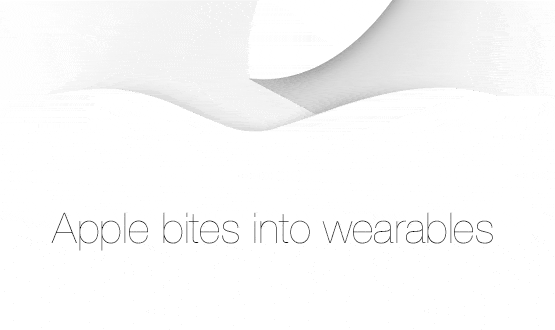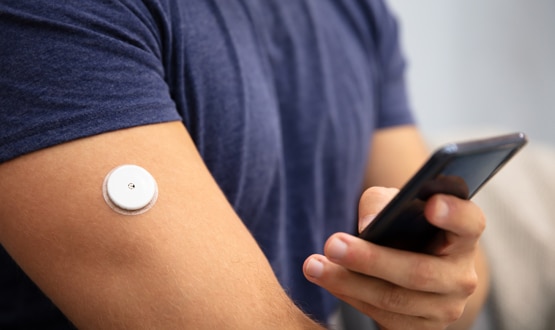Apple bites into wearables

When Apple enters a market, competitors – and the world – take notice. So it’s no surprise that the company’s anticipated arrival in the wearable technology sector has generated a huge amount of speculation about what it might entail.
The answer will become clear this evening, when the company announces a new range of products – one of which is expected to be an ‘iWatch’ that will support health apps [update: the watch was called the Apple Watch, but speculation about its health functionality was remarkably well informed – see update below].
While there are a number of smartwatches and other wearable devices on the market, analysts are hoping that Apple will break new ground by creating something more complex than a fairly rudimentary health tracker.
The watch itself is expected to include more than ten different sensors, tracking movement, vital signs and footsteps. Apple’s HealthKit development platform, which was announced earlier this year, provides the ability to store around 60 different types of data, including blood pressure and glucose level.
From wellness to health
Dan Bladon, co-founder of digital health design consultancy and app developer Design and Prosper, says the entry of Apple into the wearables market coincides with shift in interest in devices for “wellness” and fitness to their potential for medical use.
“We’re at the point where it looks like moving on more from personal wellness into the medical side of things, but the line for that is still to be determined,” he says.
The wearables market is undoubtedly on the rise, with the sector expected to cross £5 billion in value and 112 million connected devices by 2018.
Bladon owns several health wearables, including a Jawbone and a Withings Pulse, but says the existing products on the market are of more use for fitness freaks than patients managing long term conditions.
“I’ve used it a lot for running and it’s very useful if you’re training for something… but there’s nothing I’ve used yet that deals with actual health concerns.”
In contrast, Apple’s partnerships with American medical organisations such as non-profit medical practice The Mayo Group and electronic patient record supplier Epic Systems may be a sign that its device is being developed with a clinician’s needs in mind.
“A lot of [Apple’s] partners are medical institutions rather than wellness organisations, so it will be interesting to see how far it is going to cross from something that measures steps, the calories you burn and your sleep patterns, to a more detailed medical approach.”
Medical records platforms, then and now
Bladon points out that the HealthKit platform could also act as a data repository for people’s medical information by monitoring their symptoms, logging the data and allowing them to send it on to their doctor if they choose.
“I think they’re [Apple] still on a bit of a journey trying to understand how deep they can go into the management of health data and how it can be used across health organisations. There’s the question of whether they want to become an additional health record system and have health organisations plug into HealthKit.”
Previous attempts by big companies to develop this kind of platform have not exactly born fruit. Google also caused huge excitement when it launched the Google Health personal health record service in 2008, but it cancelled the project in 2011.
Microsoft’s HealthVault platform was lauded by the present government when it was in opposition, but it was nearly canned when the company decided to shift its focus away from healthcare software. In the UK, its main use has been as the platform for patient record projects developed by trusts.
Apple may have more success. The advances in wearable tech mean people have an easier way to generate the kind of data these platforms require.
And Bladon notes that other manufacturers are exploring how their devices can be used in a healthcare context. For instance, the Michael J Fox Foundation has partnered with Intel on a project using smartwatches to track the physical symptoms of Parkinson’s disease sufferers and determine how they respond to different medications.
Lots of potential
The potential of a wearable device that can successfully make a leap into healthcare is huge: in a column for EHI, GP Dr Neil Paul speculated that an iWatch could be used to detect falls, measure heartbeat abnormalities and even provide an early warning of hyperglycaemia.
At a wearable technology conference in London earlier this year, US analyst Shane Walker predicted that monitoring your activity using a tracker could become a prescribed treatment within the next year.
“You will be handed an activity monitor tied into your doctors’ electronic medical record, programmed when you leave the doctor’s office,” he said.
However, Bladon is quick to note that wearables are still at an “embryonic” stage when it comes to their use in a medical context, with a number of obstacles still to be navigated.
One issue at the forefront of people’s minds is data privacy, after a hacker broke into the iCloud accounts of celebrities and posted their naked pictures online.
While Apple have denied that their systems were at fault for the breach, Bladon says general concerns from the public about how their medical data is shared are enough to slow down the rate of progress.
“You don’t need to be a rocket scientist to see the backlash from the care.data programme, so I think it will take a while to get to the point where they will be using data [from wearables]. As we go through the process of understanding what is and isn’t acceptable, I think that will slow things down.”
Privacy – and price – are obstacles
Price is also a problem: a Samsung Gear 2 smartwatch costs over £200, excluding the smartphone that is needed for it to function, and the long-contract for calls and data services that the phone requires.
Bladon says the cost may prove prohibitive for both hospitals and patients.“It’s a nice idea to want to have a product that works across multiple platforms and is integrated into multiple institutions, but it would be financially crippling for hospitals.
“We’ll have to see whether people living with a chronic condition are willing to spend £250 on something that may or may not help them.”
The lack of evidence for the medical value of wearables is another potential stumbling point, with little in the way of research to show whether they can make a difference to somebody’s care. “How do you build an evidence base and prove that these things can have therapeutic value?”
Building the evidence base
Bladon says large-scale testing within a healthcare context is unlikely, with smaller batch-testing and independent research papers likely to be the best way to determine the efficacy of the devices.
He believes the US, more than the UK, is likely to lead the way on integrating wearables into healthcare, which he attributes to “the nature of the system” here.
“It seems to me that there’s more innovation happening in the US because the nature of the system. In the UK, we’re held back slightly by the nature of the NHS, because it’s quite disparate.”
However, Apple – and any other manufacturers who want to move their devices into the healthcare sector – will still need to navigate the issues of integration and interoperability with the different EPR suppliers on the market.
“The problem they have is that every market is different, and not every patient management system is the same, so it’s an incredibly difficult task to take on.”
While it is undoubtedly difficult, Bladon believes it is a challenge that Apple has the resources to meet. “When Apple gets involved, it’s newsworthy because they wouldn’t make a decision that’s not strategic and well thought out.”
In the end, what is more important than the hoopla surrounding the launch will be whether the iWatch has broken into the medical sector a year from now, or whether it joins the other fitness trackers gathering dust in their owners’ homes.
“They’ve got a pitch and a story that it’s exciting, and we’re integrating one of our own apps with HealthKit because it’s exciting, but a year down the line, what is the result of this launch, and how many are used in hospitals?”
Update: Apple launched the Apple Watch alongside a new iPhone and a contactless payment system at its headquarters in Cupertino on Tuesday evening.
As predicted, the watch works with the iPhone and HealthKit. It includes a heart rate sensor and accelerometer, alongside an 'activity' app that displays graphic information about daily activity, such as how many minutes of 'brisk activity' have been completed.
There is a separate 'workout' app for cardio sessions, while the iPhone has 'fitness' and 'health' apps to capture information over longer periods of time. The iPhone apps feed HealthKit, whch can also be used with third-party heatlh and fitness apps.
The watch will not be released until 2015, and will be available in two sizes and a range of colours, with prices starting from $349 (£216).




